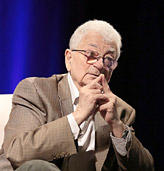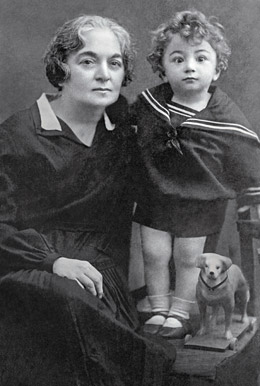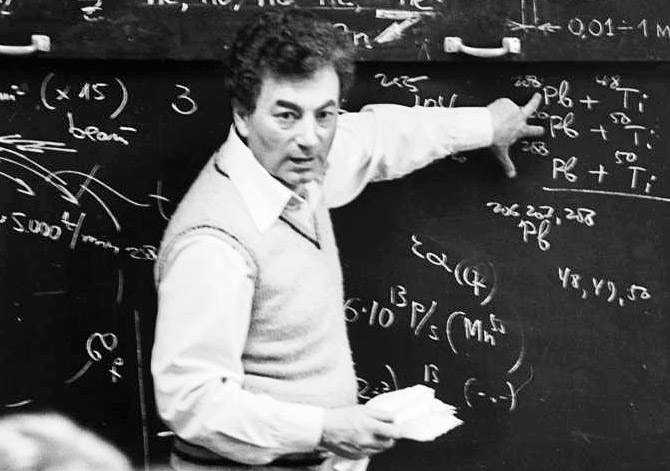
Electronic english version since 2022 |
The newspaper was founded in November 1957
| |
To the 90th anniversary of Academician Yu.Ts.Oganessian
Man on the background of the era
In the introduction to the book "Academician Yuri Tsolakovich Oganessian" that has recently been published by the RMP publishing house, JINR Director Grigory Trubnikov writes: "Academician of the Russian Academy of Sciences Yuri Tsolakovich Oganessian, our outstanding contemporary and compatriot, turns 90 years old. This is hard to believe, looking at the enthusiasm and vitality with which he continues to work at his international centre in Dubna and at the Russian Academy of Sciences."
 Selecting materials for the book - photographs and documents, preparing and editing texts, I was really amazed at the extent of Yu.Ts.Oganessian's work. His efficiency, commitment to results, dedication are characteristic of the entire period of his activity, starting from LIPAN, where he worked for the outstanding scientist and organizer of science I.V.Kurchatov and the first days at JINR (that is, since 1958), where he started to work for another outstanding physicist G.N.Flerov. It is a great success to be close to such titans, to see how they embody their ideas. But success should be followed by the results of one's own labor. And they have been. Bright, weighty, obtained in creative collaboration with colleagues from the Laboratory of Nuclear Reactions. At the first stage, this is, of course, the launch of the unique U-300 accelerator, at which the first ion beam was obtained in September, 1960.
Selecting materials for the book - photographs and documents, preparing and editing texts, I was really amazed at the extent of Yu.Ts.Oganessian's work. His efficiency, commitment to results, dedication are characteristic of the entire period of his activity, starting from LIPAN, where he worked for the outstanding scientist and organizer of science I.V.Kurchatov and the first days at JINR (that is, since 1958), where he started to work for another outstanding physicist G.N.Flerov. It is a great success to be close to such titans, to see how they embody their ideas. But success should be followed by the results of one's own labor. And they have been. Bright, weighty, obtained in creative collaboration with colleagues from the Laboratory of Nuclear Reactions. At the first stage, this is, of course, the launch of the unique U-300 accelerator, at which the first ion beam was obtained in September, 1960.
 |
| Grandmother Elizaveta Khristoforovna Seferova with her grandson Yura. Rostov-on-Don, 1935 |
I would like to highlight the following.
First. Yuri Tsolakovich is the author of the discovery of a new class of nuclear reactions: cold fusion of massive nuclei that at present are widely used in various laboratories around the world for the synthesis of new elements. While working on this material for the book, Yu.Ts.Oganessian took a three-day pause, for on two pages it was required to give a compressed, but at the same time clear and solid text about the exciting events that unfolded in the 1970s. We got a rather good text! The idea, implemented in FLNR by partisan methods, caused that for almost 40 years all subsequent 7 elements from 107 to 113 were synthesized in cold fusion reactions. First in Germany, later in Japan. The German colleagues could not understand in any way why the Dubna scientists, having invented this technique, did not use it themselves for the synthesis of new elements. Yu.Ts.Oganessian had a simple answer to this, "If you can do it better than we can (in Darmstadt a new powerful accelerator and facilities were constructed for this area - M.L.), then please, do it."
"But that's your technique!" some scientists wondered in Germany.
"Yes, the technique is ours and the results will be yours. It's all right, it is important to get results. We don't suffer from an inferiority complex...

V.M.Plotko, Yu.Ts.Oganessian, V.A.Druin during experiments on the synthesis and investigation of the properties
of elements 104 and 105. 1970
Second. This is when the rarest calcium-48 was issued from the Gokhran of the USSR to JINR. Only 10 grams. But this amount was enough for Yu.Ts.Oganessian to make the "magic calcium" work on the accelerator. And Yuri Tsolakovich was almost on the chopping block. At least, JINR Director N.N.Bogolyubov said, "Yuri Tsolakovich, they can put you in jail..."
It worked out. And most importantly, there was a result. What is this? Intuition, overconfidence in abilities. Or adventurism. Naturally, it is quite healthy adventurism. Or maybe it works in combination? Let everyone who opens the book tries to get the answer.

Professor Yu.Ts.Oganessian is making a report. 04.14.1983
1990s. Yu.Ts.Oganessian - Director of FLNR. Many people remember what happened in politics and economics. For most industrial enterprises, design and scientific organizations, this was a time of survival. What Yuri Tsolakovich did at FLNR is a biblical story for me. To take the strongest with you, to indicate the goal (Oganessian himself told me that many in the laboratory thought that the director was "crazy"), to go with his people over the abyss of economic lawlessness and to lead them to those places that the travelers set as their goal and which for the world's best physical laboratories appeared only in dreams - is this not a miracle! But that's how it turned out in reality.

British radiobiologists Prof. Donald Newton (left) and Prof. Eric Voyce are negotiating the delivery
of the first batch of "safe" plutonium. 1992
I envy myself, because for five months I have worked on the book together with Yu.Ts.Oganessian. An outstanding scientist, Academician of the Russian Academy of Sciences, only he and the American physicist Glenn Seaborg during their lifetimes saw a chemical element to be named in their honor in the Mendeleev's Periodic Table. In November 2016, the International Union of Pure and Applied Chemistry approved the name "Oganesson" for the 118th element - today, the last and heaviest element in the Periodic Table. And also, Yu.Ts.Oganessian is a member of a number of national academies, an honorary doctor and professor at famous Russian and foreign universities. But at the same time, in the process of working on the book, I saw in front of me a person open to communication, thinking in an original way, with a pleasant smile. And no pressure of authority.
In my biographical books, I try to show a person against the backdrop of an era. It makes the book interesting and educational. I'm curious about who the main character's parents are, how he was brought up, studied, how his formation went, when time and environment shaped his personality. This is important in order to understand with what kind of life baggage a person came to his heights, when he himself began to change his environment and influence the course of time. This is the manifestation of the scale of personality. It is also an opportunity to show the younger generation that it is not the gods who burn the pots. If you yourself are so purposeful and hardworking (addition to all, and surely have got talent and a little luck), then you can also reach your heights.
Here, in this book, the initial chant includes colorful pictures of Rostov-on-Don, native to Yuri Tsolakovich; Armenia, the fatherland of his father and Yerevan, where Yuri Oganessian spent his childhood and youth; Moscow in the 1950s - the city of student times. And of course, a lot of space and attention is given to Dubna with its cozy streets and wonderful people.
Many interesting people that surrounded Yuri Tsolakovich in different periods of his life come to life in the book. In addition to joint photographs, here we can also see short sketches in which Yu.Ts.Oganessian tells in a lively, vivid language about the people with whom he happened to work: Kurchatov, Flerov, Veksler, Shapiro, Plotko, Khrynkevich, Shirkov, Kadyshevsky, Sisakyan ... Such different people, but they all left a good memory of themselves. And each of them to some extent had an influence on the fate of the main character.
Toward the end of the book, there is another picture: 8 February, 2023, the Day of Russian Science, the crowded hall of the House of Culture of Lomonosov Moscow State University, there is barely room to move, young people are sitting on the steps in the aisles. And there is only one person on the stage - Yu.Ts.Oganessian. And everyone is listening to him attentively, all eyes are fixed on the lecturer. This is not just a lecture, this is a frank conversation about life, science and the future. I don't know what exactly Yuri Tsolakovich was talking about then, but I would dare to suggest that there could be such words (quote from Yu.Ts.Oganessian from the book):
"You should study because you will never have such a great time again. Five years for everything! This is just happiness! Therefore, take care of every day of these five years, try to take the maximum possible. But God forbid you pore over books all the time. You should go to theaters, movies, concerts, travel and be sure to expand your horizons. Otherwise, on a professional line, you will not succeed: you will always think narrowly. Let something underestimate - to hell with it. But don't waste your time. Absorb knowledge, everything that happens to you and around you. It is very important".
This is for them, young people. And at the same time - it is said about himself, because the student Yuri Oganessian himself lived like that.
You will ask how the book ends. Not a dot. More like a comma. Because life goes on. And there is much more to be done.
Mikhail LUKICHEV, author and publisher of the book,
specially for weekly "Dubna"